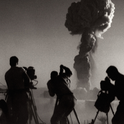In Woody Allen's 2005 movie Match Point, Londoners saw the London Eye, Tower Bridge and the Houses of Parliament—their city as tourist metonym. Those who attended the glitzy premiere of David Cronenberg's latest movie, Eastern Promises, which opened the London film festival, were confronted by a very different city: dank alleyways, a fetid bit of the Thames, a nondescript hospital and service entrances instead of front doors—monumental urbanism.
It's tempting to see the former as fake and the latter as real, but as you watch Cronenberg's vision unfold, you realise that Eastern Promises is not a response to Woody Allen's blindness to the particularities of 21st-century London. Although it was written by Steven Knight, who also wrote Stephen Frears's far more realistic Dirty Pretty Things, Cronenberg's film isn't interested in the specifics of place; but then again neither were The Fly, Naked Lunch or Crash. Cronenberg's films could be set almost anywhere. Excise the markers of individual cities, and they work as universal nightmares.
But this is not to say that physical reality is of no interest to him. Far from it. Like his North American compatriots David Lynch and Matthew Barney, he is deeply interested in texture. Though Eastern Promises is not his most visually distinctive film, he none the less appeals to our senses through the blonde softness of Naomi Watts's character, a midwife who investigates the death of a Russian teenage girl, and her contrast to the black hardness and muscularity of the Russian chauffeur who is connected to the girl's murderers. In one signature scene, the chauffeur, played by Viggo Mortensen, asks for a hairdryer to defrost a frozen human body so that he can peel open its jacket and remove a wallet. We can sense Cronenberg's relish at the involuntary way we imagine the feel of marble-hard flesh as it softens, and smell its decay.
Add this relish to the textural quality of Cronenberg's movies, and his rejection of the specifics of location, and you realise that while his films are full of wrongdoing, he isn't interested in the wrongness of wronging so much as its repulsiveness. In person, Cronenberg is a liberal Canadian, but in his cinema he takes the wrongness of murder or gangsterism as read, and instead is intrigued by how nice, blonde, decent, liberal people like Naomi Watts's midwife (or we the audience) react to it as material. Cronenberg's films are about the form of evil rather than its content.
Plonk this distinction into movie history, and things become interesting. Moralists as varied as Ken Loach, Oliver Stone, Woody Allen, John Grierson and Claude Lanzmann censure with content. Loach at his best, for example, does so in a wholly integrated way—story, theme, characters and social world unite to deliver a compelling truth about injustice. American gangster movies of the 1930s—Scarface, The Roaring Twenties, Little Caesar and so on—were often less integrated, thrillingly portraying the rise of Chicago hoodlums in acts one and two, then delivering the sort of come-uppance society required by showing their fall in act three. So concerned was Hollywood that Scarface should be suitably moral that it added a subtitle to the film: The Shame of the Nation.

Then there are those directors who don't censure wrongdoing at all, either because they see little to disapprove of in their characters' behaviour (mid-period Clint Eastwood, most of Michael Winner), or because they are brave enough, or society is temporarily tolerant enough, to allow the wrongdoers to go unpunished. Hence the furore over Bonnie and Clyde and The Godfather, which were like those 1930s gangster movies but with the moral lesson lopped off the end. Though their characters came to sticky ends, it was possible to see them as heroic.
Cronenberg is certainly brave in his square-on, close-up depiction of violence. He doesn't denounce and by now we don't expect him to. But more than most, he loves to cup the form of moral transgression in his hands and, as it were, rub it against our cheek (or elsewhere). He's interested in the cheek that is being rubbed—in the person who is repelled by slit throats, dead bodies, gynaecological instruments (Dead Ringers) or rubber and metal sex (Crash). We remember his movies because they are sensory screeches rather than intellectual sermons. The former sticks more than the latter. Most interesting of all, I think, they have a moths-to-a-flame structure. Naomi Watts keeps going back to the gangster underworld for more. Geena Davis is repelled by Jeff Goldblum's scientist in The Fly, but then fascination and attraction take over and she can't stop going back and looking as he turns into an insect or vomits on his food. Cronenberg's movies are structured in such loops. Their narratives zoom in on dark, fascinating "hot" places, get singed and then flee outwards to the cool air of liberalism. But they aren't out in that air long before the heat, the form of wrongdoing, begins to compel once more. The cool Canadian has come to a hot place, London, and partially, only partially, captured its heat.











